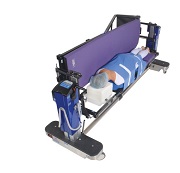Roughly 80% of the world’s population suffers from lower back pain caused by spinal disorders.
Spinal fusion surgery is often the most-utilised intervention for lower back pain and costs the NHS an estimated £1.6billion a year.
To address this, Hillrom has introduced the Allen Advance Table Lateral to Prone (L2P) Platform designed with patient positioning challenges in mind.
The platform allows for simple patient movement, maximising efficiency of lateral spine procedures and pedicle screw fixation, maintaining safety of operating room staff, and improving patient outcomes.
The table is compatible with the Lateral to Prone (L2P) platform which provides caregivers with a flexing lateral support.
This allows for 90-degree rotation of the patient from lateral directly into a prone position when used with the Allen Advance Table with locking capability.
Its unique rotational capabilities also allow right and left-side lateral approaches without logrolling patients.
The introduction of the L2P platform addresses the challenge of patient repositioning, allowing surgeons to benefit from minimally-invasive lateral spinal approaches, while maintaining time efficiencies and protecting patient and caregiver safety.
And the platform overcomes the process of repositioning and re-draping the patient.
Benefits include:
- Secure and controlled movement of the patient
- Time savings over traditional patient movement approaches
- Fewer caregivers are required for intra-operative patient transfer and reduced risk of manual handling-related injuries for caregivers
- Removing the need to swap tables in and out of the OR, thus reducing infection rates
In cases of spinal injury, the cervical spine must be stabilised in the operating room as undue motion can put patients at risk of further injury.
Traditional approaches of logrolling a patient require manual stabilisation of the patient to minimise lateral spinal movement which can harm them.
But research suggests that overall cumulative motion to the spine can be reduced by as much as 50% if alternative measures to the ‘logroll’ are employed.
With the lateral-to-prone approach, the 90-degree rotation can be performed in a secure and controlled manner, reducing the associated risks of cervical spine movement.
Patient transfers and lateral positioning present risks to patients and caregivers alike.
Lateral patient transfers currently present the most-frequent cause of spinal and shoulder musculo-skeletal disorders for nurses.
Without the L2P platform, however, a patient transfer from the lateral-to-prone position will require around five OR staff members to lift the patient to a gurney and then switch the OR table to a prone frame, putting caregivers at increased risk.
The Lateral to Prone platform is currently in place in four NHS trusts, including the Royal National Orthopaedic Hospital NHS Trust (RNOH), an internationally-recognised leader in research and development of orthopaedic medicine.
The Spinal Surgery Unit at RNOH Stanmore pools the skills of multidisciplinary experts to treat a variety of spinal presentations.

It offers time savings over traditional patient movement procedures
Consultant orthopaedic surgeon, Robert Lee, specialises in complex spinal surgery, treating countrywide spinal referrals.
The L2P platform is currently being utilised by Lee to support his work in minimally-invasive fusions and decompressions, with a focus on fast rehabilitation and maximum preservation of the paraspinal musculature.
He said: “At RNOH we perform complex adult reconstructive surgery involving restoration of the anterior column with cages inserted from the lateral or oblique position followed by posterior fusion.
“We have started using the Allen Advance Table Lateral System with the lateral-to-prone platform for our one stage anterior/posterior cases.
The platform enables us to turn the patient from lateral to prone without having to logroll them.
“This has resulted in faster repositioning between stages, less danger of cage displacement, and safer manual handling for the theatre staff.”
